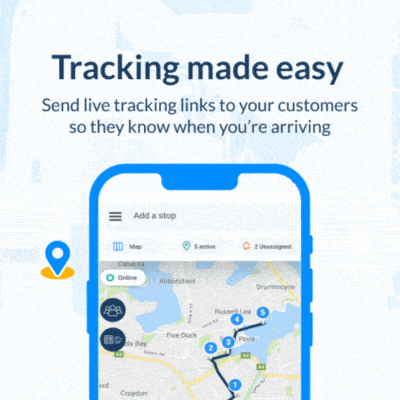Fuel is expensive! It represents 60% of a fleet’s total operating budget. However, if your delivery driver is suddenly speeding, as much as 20% more fuel is consumed. That’s why fleet management software plays a vital role in fuel efficiency.
Monitoring delivery drivers’ fuel consumption, driving habits, and idling time can save your business money.
If only you knew how to make these small changes, that can greatly impact your fuel budget. According to FleetClear, if you simply minimize excessive idling, you can save up to $8,000 per vehicle annually on wasted fuel.
Here are ten facts to prove why fleet management is needed to cut fuel waste.
- Aggressive driving increases fuel use
- Maintaining proper tire pressure saves fuel
- Reducing speed boosts fleet efficiency
- Telematics can cut fuel costs by 15%
- Load weight affects fuel economy
- Cruise control saves fuel on highways
- Air filters impact fuel use
- Route optimization systems save money
- Regular maintenance is important
- Idling wastes fuel
Now, let’s discuss in detail how you can implement these small changes to impact your annual budget dramatically.

Now, let’s discuss in detail how you can implement these small changes to impact your annual budget dramatically.
What is fleet management?
Fleet management solution helps you track, assess, diagnose, and identify critical areas for improvement, ensuring that your fleet operations improve, stay well-maintained, and are not damaged.
Good fleet management systems can help you cut down on maintenance costs, fuel costs, and road time.
It ensures that all cars, vans, scooters, e-bikes, and trucks are regularly sent for maintenance, plans the most efficient routes for deliveries to ensure a longer lifespan for the vehicles, and saves fuel consumption for better engine output.
Poor driving habits are the main culprit for the excessive use of fuel.
Now that you know what fleet management is used for, let’s dissect the ten ways fleet management software can help your business improve efficiency.
1. Route optimization minimizes fuel consumption
It’s a problem to drive around the neighborhood for 10 minutes, ask for directions, and battle to find the address where the next delivery or stop has been assigned.
Your customer is frustrated. The delivery is late, the fuel is burning, and trust me, the driver is also seeing red.
When routes are optimized with real-time data, this dilemma can be avoided.
And it doesn’t even need to be this drastic. Simply using a route that is believed to be the shortest but is not can cause delays and more fuel consumption.
When a company is using fleet management software, it can adjust its routes in real time based on traffic patterns, road closures, and weather conditions.
Route optimization software can reduce empty miles
Empty miles is when you drive around clocking in miles, but you have almost nothing in the van, and you’re also not earning any revenue.
This happens when you are not using software to avoid these redundant trips, wasting precious time and money.
With more efficient paths to each destination and the shortest idle time between the various stops, time and fuel usage is more efficient.

2. Monitoring delivery drivers’ habits improves fuel efficiency
Aggressive driving behaviors like rapid accelerating or harsh braking are significant contributors to higher fuel consumption.
The optimal fuel usage depends on the type of vehicle. However, according to FleetClear, the speed should typically be between 35 and 50 MPH.
But how would you know how hard they are braking or accelerating? Fleet management software can track these behaviors.
How will you change this excessive driving? By pointing out the problem showing which driver is the culprit, at what time of day, in which area, and to what extent, the fleet manager can address the problem directly with the specific driver.
3. Reducing idle time cuts down fuel waste during deliveries
Idling wastes fuel. It’s a hidden cost, especially in the delivery space. Drivers think that not cutting the engine while quickly stepping out of the vehicle to hand over a parcel is saving time; it’s burning fuel!
If a driver will be idling for more than 60 seconds, it’s better to switch off the engine. According to Teletrac, an idling vehicle can consume one to one-and-one-half gallons of gas per hour.
How can a fleet manager know about idle times? Fleet management software can pinpoint idle time. It helps managers to coach drivers when to turn off their engines.
When it comes to scheduling deliveries, there needs to be more mindfulness to minimize waiting time.
4. Using preventative fleet maintenance improves fuel efficiency
Keeping your vehicles in top shape with fleet management software improves fuel management.
How? Properly maintained vehicles consume less fuel. Fuel consumption is better when the engine, air filters, and oil maintenance are updated.
You’ll get more mileage per liter of fuel. Oil minimizes friction, allowing smooth flow through the engine.
Expert Market reports that regular vehicle maintenance using telematics data can extend a vehicle’s lifespan and reduce repair costs.
What should you focus on to maintain your vehicle and reduce fuel costs?
Tire pressure
Underinflated tires have less grip and use more fuel.
Regular oil changes
Clean engine oil reduces friction and helps the engine run smoothly, improving fuel efficiency.
Air filter maintenance
A clean air filter ensures proper air intake, which optimizes fuel combustion and reduces fuel consumption.
Engine tune-ups
Keeping the engine in good condition, including checking spark plugs and timing, ensures efficient fuel use and better overall fleet performance.
5. Using telematics for fleet management saves costs
Telematics gives fleet managers real-time insights into how you can save fuel. This helps managers make quick decisions and adjustments that can help save costs at the end of the month.
With real-time telematics, you don’t have to wait until the end of the month to receive a full report on how a driver has been driving a car or which vehicle has been falling behind with maintenance.
With accurate data, managers can compare fuel usage between drivers and identify areas where it can be improved.
NOW READ: What is delivery management?
Share this article
About the author
Mia is a multi-award-winning journalist. She has more than 14 years of experience in mainstream media. She's covered many historic moments that happened in Africa and internationally. She has a strong focus on human interest stories, to bring her readers and viewers closer to the topics at hand.














